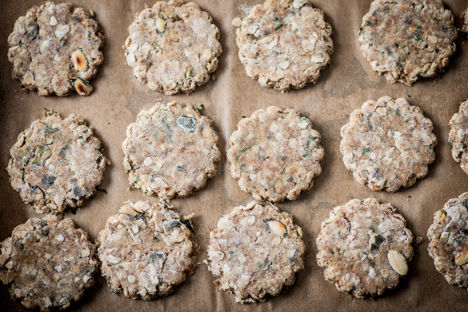Italian biscotti, Scottish shortbread, American cookies, German Lebkuchen, Australian Anzac biscuits – most countries have a favourite biscuit. The most basic recipes involve flour, butter and sugar but the possibilities are almost endless. Spiced with ginger or cinnamon, decorated with icing, dipped in chocolate, sandwiched with buttercream . . . whatever the variation, almost all of them are completely delicious dunked in a cup of tea.
How to make biscuits
Often biscuits are made from a dough which is rolled out like pastry and then shaped with a biscuit cutter. Batch biscuits like these usually involve basic techniques like creaming together butter and sugar, beating an egg or separating an egg. To learn or revise these basic baking techniques consult our 'How To' guides.
Not all biscuits are designed to be uniformly cut, though. The charm of a cookie or flapjack comes from a homemade look which involves ditching the cutters and getting your hands involved. These less stringent techniques range from gently pressing an oat flapjack into a tray to flattening balls of dough into cookies.
At the other end of the scale are intricate and stylised biscuits like florentines or macarons which employ more advanced techniques.
Decoration is a big part of biscuit-making. This could range from glace icing to royal icing to a fondant coating or buttercream filling. It might be drizzled, piped or poured.
The three best indicators for telling whether a biscuit is cooked are colour, consistency and smell. Often a biscuit which started as a pale dough will turn golden when it is cooked and start to colour a little round the edges.
Of course, that isn't always the case; shortbread remains pale even when cooked and recipes which use brown sugar rather than caster, like gingersnaps, will always turn a deeper golden colour. Frustratingly, lots of fan ovens cook in a lopsided fashion and often trays will need turning half way through cooking to ensure an even bake and consistent colour.
The consistency or 'snapability' is another good indicator. Again, this varies from biscuit to biscuit and requires a certain amount of judgement. For example a thick American cookie will be softer than a thin cracker. Most biscuits harden as they cool, though, so bear this in mind. It's good practice to let a biscuit rest on the baking tray for five minutes before transferring to a cooling rack and then leaving to cool completely before moving to an airtight container.
Serving suggestions
A biscuit is an excellent vehicle for both savoury and sweet dishes. From Adam Stokes' Seaweed crackers to go with mackerel to Pierre Koffman's Sablé biscuits with dark chocolate mousse, they make a practical, flavoursome and texturally exciting garnish or side.
Get in touch
Please sign in or register to send a comment to Great British Chefs.


